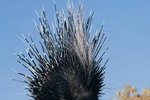
Badgers are mammals that belong to the Mustelidae, the largest family of carnivores, that includes weasels, stoats, ferrets and otters. Heavy-set and short-legged, badgers live in underground burrows, called setts, with elaborate tunnel systems. They trap their prey and their strong jaws keep a good hold on the animals they catch. Solitary badgers will defend their young from larger hunters such as wolves, coyotes or bears.
Description and Habitat
Badgers are omnivores; they mainly eat worms, but also insects, small amphibians, mammals, reptiles, and even birds, plus seeds and berries. They can reach three feet in length and weigh about 25 pounds.
The eight species of badgers -- all stout, with short, stubby tails and very sharp claws -- may vary in feeding habits and choice of habitats. For example, the American badger wanders, digging a new burrow every few days; the European badger uses warrens many years old.
Species of Badgers

The eight species of badgers are; the Eurasian badger (Meles meles), American badger (Taxidea taxus), the honey badger (Mellivora capensis; also called sand badger or ratel), the hog badger (Arctonyx collaris), three species of ferret badger (Melogale), the Indonesian stink badger/Teledu (Mydaus javanensis) and the Palawan or Calamian stink badger (Suillotaxus marchei).
The three subfamilies are; Melinae (the Eurasian badgers), Mellivorinae, (the Ratel, honey or sand badger), and Taxideinae (the American badger). Formerly the Asiatic stink badgers of the genus Mydaus were included in the Melinae, but it is now known that these are Old World relatives of the skunks (Mephitidae family).
Habitats
American badgers (Taxidea taxus) live in the western and central United States, northern Mexico and central Canada. They range from the Great Lakes states west to Pacific Coast, and from Canadian Prairie Provinces, south to Mexican Plateau. They also can be found further east, in Maine, Pennsylvania, and New Hampshire.
Eurasian badgers (Meles meles) are found in most of Europe, from Ireland and Britain eastward to Russia, Mongolia, Japan, China and Tibet, generally in forests with substantial scrub.
The remaining species are found in Southeast Asia.
Threats to the Badger
The development of agriculture and housing for humans is a major threat to the badgers' habitats. They may eat poison left out for coyotes and thousands are hit by cars while trying to grab road kill.
Badgers have few natural enemies. Their strong body structure, powerful jaws, thick skin and keen sense of hearing and smell are good defenses. The increase in the number of ground squirrels in the western United States favors the growth of the American badger population. When frightened, badgers produce a strong scent that discourages predators.
Badger-baiting was outlawed in Britain in 1835, but elimination efforts from the 1960s through the 1980s were an effort to combat rabies and bovine tuberculosis transmitted by them. The Protection of Badgers Act was finally passed in 1992.
In 2000, the Canadian Species at Risk Act listed the subspecies Taxidea taxus jacksoni and Taxidea taxus jeffersonii as endangered. California classified the American badger as a species of special concern. The endangered honey badger experiences greater threats due to traps set by apiculturists and farmers. Badger body parts (paws, skin and organs) are valued in traditional medicine, although some species are legally protected in Middle Asia and the Mediterranean area.
References
Resources
- The IUCN Red List of Threatened Species. Mellivora capensis
- International Wildlife Encyclopedia; Maurice Burton and Robert Burton, eds. (Marshall Cavendish Corporation; 3 ed. (January 2002)
Photo Credits
-
Photos.com/Photos.com/Getty Images
Writer Bio
Kathleen March has been a writer for 40 years. A professor and translator of Spanish, Portuguese, and Galician, she has studied several languages and uses them for travel and research. She enjoys medieval architecture and avant-garde poetry. Her work has appeared in numerous critical journals in the U.S. and Spain.




